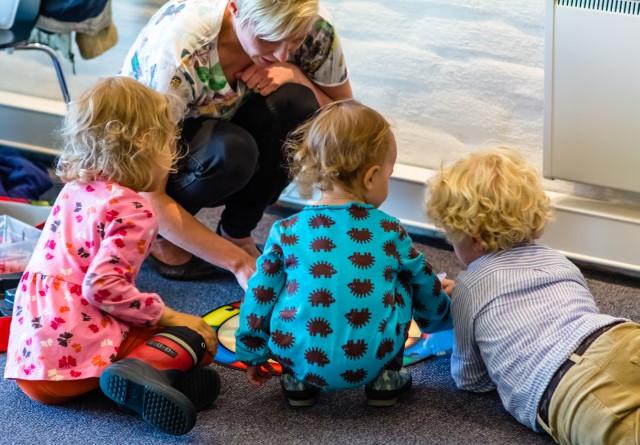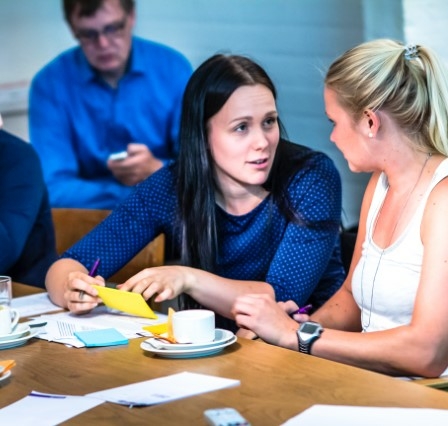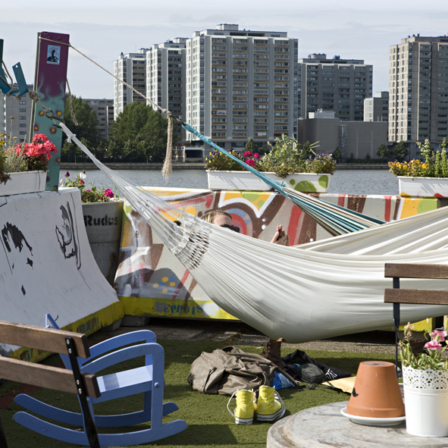Families in Jyväskylä in central Finland have been pursuing a resource-wise life of the future. As part of an ambitious project, they have been able to markedly reduce their consumption of natural resources and their carbon emissions. The most positive environmental impacts came about through new transport solutions and adjustments to the families’ diets. And the best part? The families enjoyed the changes.
“Each grocery run saved us almost two hours of personal time, which we highly appreciate,” said Salla Pehkonen, a mother of two, whose Jyväskylä-based family participated in the Household of the Future project. The Pehkonen family tried ordering their groceries through a service that delivers from the store to the customer’s front door. This service reduces the need to use private cars and other transport – and saves customers time and effort. The service impressed the Pehkonen family, who have continued to use it after the project, encouraging their neighbours and friends to do likewise.
Sitra invited five households in Jyväskylä to try out the resource-wise living of the future as part of the Household of the Future project. Together with D-mat oy and Big Plans Bakery, the project sought ways of making households more resource-wise in their everyday lives. This was measured by looking at their material and carbon footprints. A list of experiments was brainstormed for each household based on the results of their measurements, with a strong focus on food, transport and housing – namely the three areas of life with the greatest environmental impact. The project included carsharing using an electric car, home delivery of groceries, adjusting meat-based diets in line with healthy eating recommendations, swapping detached houses for downtown apartments, favouring public transport over passenger cars, more telecommuting, plans for energy-efficiency improvement projects for apartments, and more efficient use of a household’s square metreage.
The material and carbon footprints of all five households were reduced significantly during the experiment. For example, Kimmo Suomi and Eeva-Liisa Vihinen managed to reduce their material footprint by more than half. The couple moved from a large suburban house into a two-room apartment in central Jyväskylä for the duration of the experiment. Not only did a smaller city centre apartment reduce their material footprint by one tenth, it also had a significant impact on their daily need for transport. Through less frequent use of vehicles, they were able to reduce their material footprint by up to 39% and their carbon footprint by 31%.
“Here we are, wondering at our first morning in a two-room apartment. Apartment blocks surround us, but at least we catch a glimpse of the lake… soon I will WALK to the office!” Eeva-Liisa Vihinen wrote on Facebook on 4 November 2014.
The five members of the Laukkarinen family also significantly reduced their footprints during the project: their material footprint by a quarter and their carbon footprint by almost a half. The key factor behind smaller environmental loads was replacing personal cars with shared cars and the on-demand bus service Kutsuplus. Since Kutsuplus was unavailable in Jyväskylä, this was simulated by using taxis: each household had a set of agreed times and routes by which they could travel by taxi. This saved time, fuel and the environment, particularly when transporting the children to their hobbies.
“Since we need to spend less time driving the children around, Mari and I have more time together,” says Antti Laukkarinen describing the results of the experiment.
“This was not a particularly burdensome solution. As a matter of fact, Kuohu’s [a district of Jyväskylä] urban community is planning to come up with ways of developing shared services, particularly for transport,” he adds.
The four members of the Pehkonen family started out with the smallest environmental load of all the participant households. During the project, they managed to reduce this even further by having groceries delivered to their home and switching to a vegan diet, effectively eliminating animal products from their dinner table. Tytti Simola and Eveliina Keinonen are flatmates, both of whom are studying Sport and Health Sciences. They planned their meals in advance with a nutritionist, had their groceries delivered and cut their meat consumption in line with healthy eating recommendations. They managed to reduce their material footprint by an astounding 1,000 kilograms per year – and their amount of food waste as well.
Liina Vartia forms her own single household. For her and many others the most enjoyable experiment – and a way of significantly reducing environmental loads – lay in sharing a Tesla, an electric car free for use by all of the participants. The participants used their personal cars less, while testing how carsharing works in practice. The sporty Tesla also attracted the attention of passers-by.
“People gave me odd looks when I pushed my trolley to the front of the car and placed my groceries under the front bonnet. As we were in the middle of our resource wisdom experience, my bags were full of vegetables. An acquaintance I encountered in the parking area asked if my car ran on vegetables as well,” Antti Laukkarinen says. For the Laukkarinen family, which tends to do a lot of driving, carsharing also enabled the more frequent use of public transport. Their new modes of travel reduced their material footprint by 15%.
The Household of the Future project revealed that many resource-wise services – services that save natural resources, reduce emissions and improve well-being – are in demand in the Jyväskylä area.
“After the project ended, the households missed many of the services that had made their lives easier and more economic,” says Hanna-Leena Ottelin, the specialist in charge of the project at Sitra. “The project was an important one because it demonstrated that the resource-wise life we will have to live in the future does not necessarily involve limitations. There was no need for the participant households to sacrifice anything – they simply found alternative ways of doing things even more comfortably.”
“The Household of the Future project demonstrated that households can reduce their footprints, even rapidly,” according to Michael Lettenmeier, Managing Director of D-mat oy, the firm in charge of the project’s planning and footprint calculations. “However, the required infrastructure would have to develop at the same pace. As businesses offer new services such as carsharing or replanning the use of space in households, and the city supports initiatives such as new urban planning solutions and telecommuting opportunities, households will be able to make major changes quickly. This is what the world needs.”
The project’s final report (in Finnish only) includes issues such as the participant households’ experiences and household-specific measurement results.





Recommended